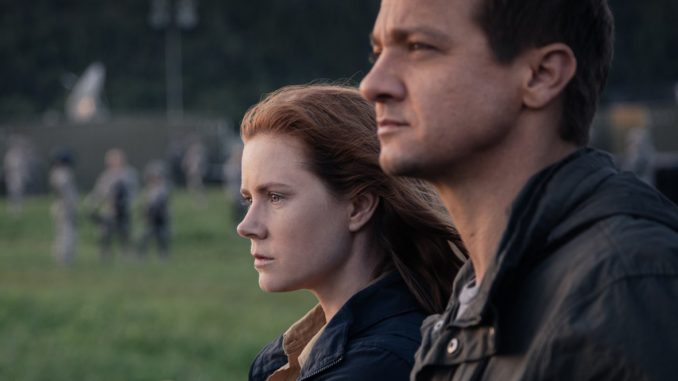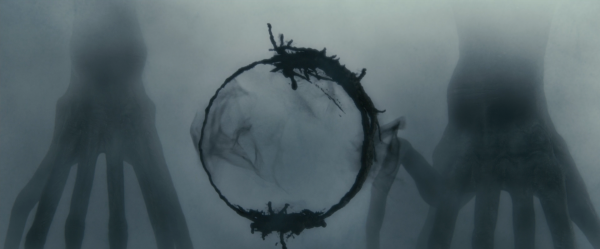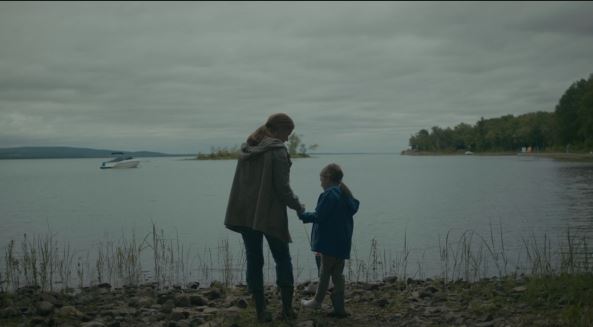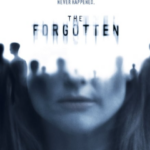Arrival (2016)
“Want to make a baby?” “Yes; yeah.” That’s the best message in this film. Put a linguist and a theoretical physicist together in a common task to save the world from space aliens, or more accurately from governments’ reaction to the aliens, and, you never know, love might blossom. So might the natural human reaction of a man and woman who love each other: let’s marry, and may our love bring forth a child.

The paragraph you’ve just read should have a giant “Spoiler Alert” in front of it. But there’s more going on in Arrival, so let’s get to the rest of the story.
The movie opens with a narration by a woman who muses about the nature of memory and time as she recalls moments with her daughter as a baby, as a child of five or six, and as a teen who dies of illness. The woman says she is not so sure she believes in “beginnings and endings” now and adds, “There are days that define your story beyond your life. Like the day they arrived.”
“They” are “heptapods,” seven-limbed, hulking alien beings who float in a misty mini-atmosphere in their spaceships, resemble giant gourd-shaped octopuses, make deep, whale-like sounds, and communicate in a language that is visual, “written” in circles – on a clear screen in their ship – with an inky substance emitted from their splayed “hands.” These aliens have landed in 12 countries in huge black, banana-shaped crafts that stand on end 20 feet or so above the ground. Their landing site in the USA is in Montana, and the U.S. military has to figure out in a hurry what’s going on.

To that end, no-nonsense Col. G.T. Weber (Forest Whitaker) takes world-class linguist Louise Banks (Amy Adams) – who is unmarried and childless at this point – to the bustling military base camp beside the alien craft. There she and theoretical physicist Ian Donnelly (Jeremy Renner) must try to contact the aliens and figure out their intentions, peaceful or not. The two are under the gun because the bellicose and antsy Russian and Communist Chinese militaries might preemptively attack the aliens on their soil – and so ignite a war of the worlds. A U.S. official, Agent Halpern (Michael Stuhlbarg), is on edge, too.
Soon Louise and Ian stand under the spaceship, are hoisted aboard and, awestruck, see the aliens, two of them, for the first time. Successive visits pave the way for the duo to create a heptapod vocabulary and to intuit how the aliens think and perceive reality. As Louise communicates with the aliens, she starts seeing mysterious visions of herself with a daughter. The aliens seem peaceful, but a cryptic message from them, “Use weapon,” alarms everyone. Things heat up when the 12 governments’ bases around the landing sites in their countries stop communicating with each other.
Chinese Communist Gen. Shang (Tzi Ma) says the world must not let the aliens “divide us,” and “humanity must be protected”; and soon he issues a 24-hour ultimatum before he will attack the aliens. Ian figures out that actually the aliens are trying to push the 12 countries together. But he and Louise are ordered to stop visiting the aliens, after a bomb planted aboard the spaceship by American soldiers who listen to angry talk shows injures Louise and Ian and ultimately fatally wounds one of the aliens.
Convinced that she must keep talking to the aliens, Louise slips away from the headquarters tent and goes back to the spaceship. SPOILER ALERT: There she asks, “What is your purpose here?” and is told that the aliens want to help humanity and that 3,000 years hence, humanity will be able to help them. A glimpse-of-the-future vision helps Louise realize that the aliens’ “weapon” is actually a tool: it is their language, a gift to humanity that “opens time” to see into the future. She returns to the base and finds that Col. Weber is under orders to evacuate right away.
The film now jumps to a scene of Louise explaining to her daughter in the future that her daddy left them because he’d learned the future from Louise and told her angrily that she’d “made the wrong choice.” She also intimates to her daughter what will happen to her. SPOILER ALERT: In another look into the future, Louise is in a concert hall when Gen. Shang approaches and thanks her for phoning him and changing his mind about attacking the aliens.
Returning to the present, where the U.S. base is being evacuated, Louise grabs a phone and speaks to Gen. Shang even though Agent Halpern is threatening to shoot her for this “act of treason.” Ian places himself between them, shielding Louise as she completes her call. An announcement comes that Gen. Shang has called off his forces and that, following his lead, other countries have done the same.
The aliens’ ship now leaves in a cloud of mist, as do the other ships around the globe. SPOILER ALERT: Ian tells Louise, “You know what surprised me the most? It wasn’t meeting them. It was meeting you” – at which she hugs him. Now comes the scene we started with, when Ian and Louise agree to “make a baby.” The film closes with more narration, as Louise addresses her daughter: “So, Hannah… This is where your story begins. The day they departed. Despite knowing the journey… and where it leads… I embrace it. And I welcome every moment of it.” A beautiful pro-life resolve we can all heed in this day and age when so many children deemed less than perfect lose their lives to abortion or euthanasia.

The MPAA rating for this film is “PG-13 for brief strong language”; as for violence, a bomb blast knocks Louise and Ian many yards back. Denis Villeneuve directed. Eric Heisserer wrote the screenplay, based on “Story of Your Life,” by Ted Chiang. Jóhann Jóhannsson composed the score. Bradford Young was the cinematographer/director of photography. Joe Walker was film editor. Patrice Vermette was the production designer. Art direction was by Isabelle Guay, Nicolas Lepage, Jean-Pierre Paquet and Robert Parle. Set decoration was by Marie-Soleil Dénommé, Paul Hotte and André Valade. Costume design was by Renée April. Casting was by Francine Maisler.
— Dan Engler













